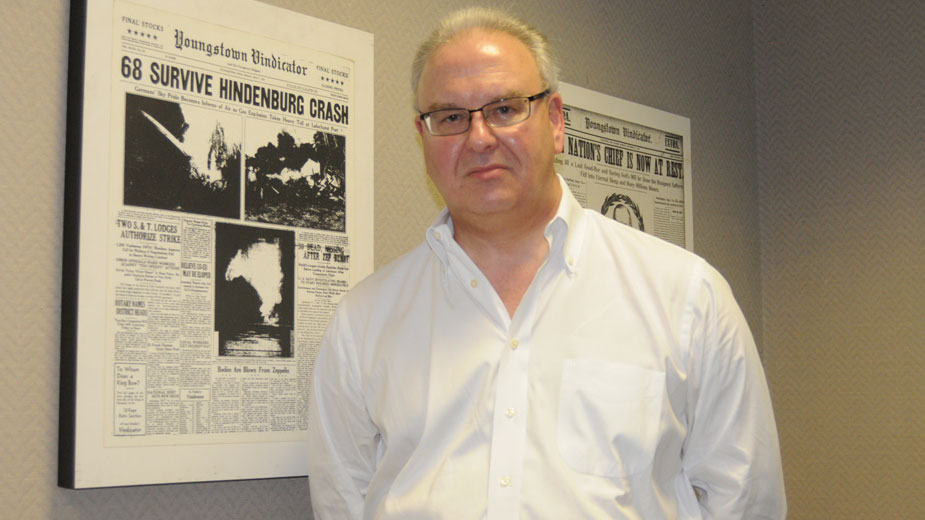The Vindicator: Industry Bellwether or Anomaly?
YOUNGSTOWN, Ohio — There is plenty of speculation. A well-financed local business team charges in at the last-minute to rescue a newspaper with a 150-year legacy and storied family ownership since 1887. A major news chain rekindles its interest, makes a major investment in a declining media market and resuscitates daily print news coverage in the Mahoning Valley.
But no white knight in sight to save The Vindicator, which is ending publication Aug. 31.
The announcement June 28 of the paper’s shutdown spooked the entire industry, many fearing it is a bellwether moment that signals a dangerous new trend in the slow undoing of local journalism and the role of a free press. Others hold out the possibility that a buyer could still emerge.
“It’s tragic,” says Bernie Lunzer, president of the NewsGuild-CWA, which represents 60 Vindicator employees.
“Unless something changes, there will be more Youngstowns,” he warns. “Without question.”
Media industry specialists and academics view The Vindicator’s inability to attract a buyer as a worrisome next phase in the future of print publishing and local news.
“My fear is that the erosion in the business model has reached a juncture where there are so few buyers and values are so depressed, that we’ll see more types of these failures like in Youngstown,” says John Chachas, founder and managing principal of Methuselah Advisors, an investment bank based in New York. Chachas has served as financial adviser to some of the largest media organizations in the world, including the Walt Disney Co., Tribune Co., and the Hearst Corp.
Chachas anticipates that more independently owned newspapers will be looking to sell, but the real question is whether there are any outfits willing to take the risk. “I presume that many independents will try to sell, but they have to have a buyer,” he says.
Overall, interest in newspaper companies is limited, Chachas says, given the migration of content and advertising revenue to digital platforms. Most noteworthy is that digital giants such as Facebook, Google and Apple earn exorbitant amounts of money by posting digital news without paying the news outlets for their content.
“Digital platforms are using the news industry’s content but paying nothing for it,” he says. “They make billions of dollars but pay no license fees.”
In 2018, for example, Google earned an estimated $4.7 billion from news content that it secured without paying a single dime to publishers, according to a study released last month by the News Media Alliance, a trade organization that represents more than 2,000 newspapers in the United States and Canada.
Newspaper publishers are reluctant to collectively take on these digital giants since doing so could be a violation of U.S. antitrust laws. The one remedy is to ask Congress for an exemption, which would allow newspapers to negotiate content fees with platforms such as Google in order to recoup lost advertising revenue.
In June, News Media Alliance president and CEO David Chavern testified before a U.S. House Judiciary Committee examining the market power of online platforms.
“Present trends can’t continue,” Chavern testified. “If we continue on this path, we’re going to lose vast amounts of quality journalism, particularly in communities all across the country. What we’ve asked for is a chance, a chance for a different kind of future, and we need that future, collectively.”
The downward spiral isn’t confined to print media, says the NewsGuild’s Lunzer. “We’ve seen layoffs in digital, and it’s important for the American citizen to understand that there isn’t a sustainable business model for free news, not just for newspapers.”
That there were no buyers willing to acquire The Vindicator was most likely the result of an overall depressed local market, rather than other factors such as the existence of a unionized workforce, Lunzer suggests.
“It hasn’t been true elsewhere,” he says of other NewsGuild papers. “There have been plenty of papers purchased with our union intact,” he says, specifically referencing the Erie Times-News, which was sold to GateHouse Media in late 2015.
Media companies scrutinize the balance sheets and determine how they can squeeze as much profit as possible, Lunzer says. Plus, the economic conditions of the Mahoning Valley didn’t help The Vindicator. “I think the owners stayed with it as long as they could,” he says.
A strike at the newspaper that began in November 2004 and lasted until July 2005 didn’t have a long-term effect, Lunzer continues. “When it was resolved, the paper did a fair amount of cutting and restructuring,” he says. “There was a good relationship once people got back on good footing.”
Lunzer says the Guild will work with Vindicator management to negotiate severance for its members over the next month and a half.
Vindicator General Manager Mark Brown delivered the devastating news to employees June 28. That evening a letter from Brown and his mother, Betty J. H. Brown Jagnow, was posted at Vindy.com then published the next day in print. Ironically, by the time The Vindicator reported it was closing, it had been scooped by WFMJ, which broke the story, and every other local news organization.
Brown is the fourth generation of the Maag family to own and operate the newspaper, founded in 1879 by James H. Odell and purchased by Brown’s great-grandfather, William F. Maag Jr., in 1887.

Throughout its history, The Vindicator was known for taking on powerful forces within the community, including the Ku Klux Klan during the first half of the 20th century and organized crime during the latter half. As the digital age took hold, the newspaper cut its size, trimmed staff where it could and made additional investments in the company.
In 2009, the paper invested $12 million to buy a newer, but used, press to replace its aging one. The investment was made, in part, because the last remaining company that supplied equipment to its antiquated press was about to fold. The Vindicator reasoned it could create new revenue streams by printing other publications and special projects for customers.
However, that business never materialized, leaving the newspaper saddled with high maintenance costs for the press. Business Journal publisher Andrea Wood confirms that The Vindicator never reached out to the Youngstown Publishing Co. about printing this publication.
This, coupled with declining circulation, placed enormous financial stress on the company. Meanwhile, subscribers bailed – many because of the migration to digital news, others because they moved to other locations across the country and others because they disagreed with the newspaper’s editorial content.
Youngstown Board of Education President Brenda Kimble told WYTV that she stopped buying The Vindicator years ago, along with others, “because of the biases in the paper.” She especially took issue with coverage of the board’s attempt to overturn House Bill 70, which appointed a CEO to manage the school district and left the school board powerless.
During the 1970s, circulation topped 100,000 daily and 160,000 on Sunday. Today, The Vindicator delivers 25,000 daily and 32,000 Sunday. In the last five years, daily circulation plummeted 50% and Sunday circulation 32%, The Wall Street Journal reported, citing the Alliance for Audited Media.
Peter Skurkiss of the conservative online daily American Thinker mused that another factor in the paper’s decline could be that it grew out-of-touch with its readership. President Donald Trump won Trumbull County during the 2016 election and nearly carried Mahoning County in what was a comfortable stronghold for the Democratic Party. The Vindicator endorsed Hillary Clinton, to which Skurkiss writes: “Maybe it was a telltale sign that the paper was stuck with a solidly Democratic attitude when many of its potential readers have moved on.”
“We never thought we’d be in this position,” Brown told The Business Journal. The Vindicator had lost money in “20 of the last 22” years, he said, and in December 2017, the paper hired a broker to find a buyer. In all, The Vindicator spent $23 million from its rainy day fund to cover its losses.
By the spring of 2018, “Several people had looked at the property but we only had two potential bidders,” Brown said. One of the suitors pulled out after it opted for another opportunity that came on the market while the other walked away citing “internal problems,” he explained.
“So we ended up with no potential buyers.”
While Brown declined to identify the parties, in the spring of 2018 New Media Investment/GateHouse Media purchased newspapers in West Palm Beach, Fla. and Austin, Texas. It also acquired the Indiana-based Schurz chain last year.
As news of the pending shutdown rippled through the country, national news organizations portrayed it as a watershed moment. Other outlets, such as the Poynter Institute for Media Studies, have posited that The Vindicator might be the victim of “special circumstances,” such as the lack of a succession plan and bad timing.
In a piece published July 9, Rick Edmonds of Poynter noted that The Vindicator’s ownership consisted of just two family members, Brown and his mother, who has worked at the paper for 71 years. While there is interest in the next generation operating WFMJ-TV, which is owned by the Browns, no one was willing to take command of the newspaper, according to Edmonds’ account.
“Maybe I should have seen five years ago that it was going to get ugly. I was afraid of the cuts [a chain owner] would make…we thought we had cut to the bone, but maybe not compared to the current standards,” the Poynter article quotes Brown. “I’m not sure whether I did the right thing…but we never imagined we wouldn’t be able to sell.”
The Vindicator reaching a deal with another party before it shuts down is not inconceivable. In 2008, when the Journal-Register announced it would close papers in Bristol and New Britain, Conn., a buyer swept in at the midnight hour and acquired them.
Brown acknowledged in the Poynter story that there has been some renewed interest in the paper since the news broke, but nothing worthy of consideration. Sources say at least one local businessman kicked the tires but found the situation too far gone.
The University of North Carolina’s School of Media and Journalism’s Center for Innovation and Sustainability in Local Media studies trends in the newspaper industry.
Penny Abernathy, Knight chair in journalism and digital media economics at UNC and author of “The Expanding News Desert,” published last year, says since 2004, the country experienced a net loss of nearly 1,800 local newspapers. Even more significant, she adds, is that since that report was published last year, another 200 papers have closed or announced they would close – including The Vindicator – almost half of them occurring in recent months.
Most of these newspapers have either been weeklies – that is, newspapers that publish three times a week or less – or dailies that served very small communities, some of which had already transitioned to weeklies before they closed, Abernathy says.
Of the 1,800 newspapers or so that shut down between 2004 and 2018, about 60 were dailies. Of the 200 that have closed since the study was published, just a handful were daily papers, she says.
“What makes the Youngstown situation different is that it’s the first sole daily in a large metro market that has been closed,” Abernathy says.
Typically, those communities that lost local newspapers tended to be in regions that are more economically distressed, demographically older and contain a population that is less educated versus other regions of the country, the UNC center’s research shows.
“If you look at the economic statistics of Youngstown – even though it’s a large market – it is very distressed,” Abernathy says, highlighted by the closure in March of General Motors Co.’s Lordstown Complex and other affected businesses.
Brown was asked by The Business Journal if the closing of the auto plant factored into the decision to stop publication.
“It did not have an immediate effect,” he said. “I don’t know if it was a factor among people looking at us.”
According to UNC’s research, “Newspapers that are located in a market that is at least on par with the national average have a better than average chance of transitioning to some sort of profitable business model,” Abernathy says.
Finding that right model remains a challenge for publishers in the face of shrinking print and digital advertising revenues, she acknowledges. But adjusting to such market disruptions can be accomplished “if you have a creative publisher who is willing to look at many diverse sources of revenue and income,” she says. “They need to invest in what serves the unique needs and expectations in these communities – and that includes residents and businesses.”
As an example, Abernathy points to the transformation of The Pilot, a 100-year old weekly published in Southern Pines, N.C. “Its market is not real affluent, but it has patches of affluence,” she says. The publisher nonetheless realized that print revenue was diminishing rapidly.
The answer was to completely transform the company’s business model, Abernathy says. The first step was to search for opportunities outside the paper’s geographical market. “They started to print telephone books for adjacent counties,” she says. Then, the company researched some of the fast-growing cities in North Carolina that lacked a proper lifestyle publication. It now owns four of them and has successfully integrated digital and video into that product.
“They also set up an in-house digital advertising agency to serve businesses in the community,” Abernathy says.
The Pilot also cut back print publication from three days to two, started an electronic product to attract younger readers, its owner purchased a troubled independent bookstore and turned it around, and then started an e-commerce site to bring in retail business.
“It’s evolved over the last four or five years from the newspaper generating 90% of the revenue to roughly 25% of the revenue,” Abernathy says. “The revenue is coming from other sources.”
Abernathy says it’s imperative that newspapers have a five-year plan that calls for the transformation of at least one-third of its operation with a goal of completely overhauling the business within 15 years.
“That’s been the same with other industries that we’ve seen go through massive disruptions,” she says. “The issue is if you wait too late to start the transition.”
Copyright 2024 The Business Journal, Youngstown, Ohio.



